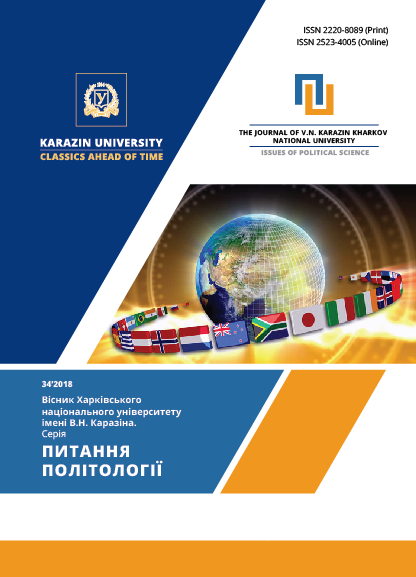ELECTRONIC PARLIAMENT: THE FUNCTIONS AND CREATION MECHANISMS
Abstract
Today, the issue of setting up an electronic parliament in Ukraine and its information and analytical support to ensure effective lawmaking activity is very relevant. In the western democratic world, parliaments widely use ICT (information and communication technologies) to optimize processes, increase accessibility, transparency, and enhanced reporting capabilities. Parliament is the main legislature institution, which demonstrates trends of new technologies, rapid exchange of information between divisions, the latest methods of processing and transmitting data in information systems. With the introduction of ICT in the parliament, key political values of the legislature should be strengthened, such as free access to information, openness, and transparency. E-democracy tools in the e-Parliament provide effective parliamentary functions, increase the quality of parliamentarism and the legislative process. New information systems make the legislature more efficient, and the tools of e-democracy and information and communication technologies enable citizens to be more involved in public affairs, through the possibility of indirect involvement in legislative initiatives. Adapting European experience can strengthen the institutional capacity of the Ukrainian parliament, deepen communication with civil society, introduce quality expert support and coordinate the adoption of new bills. This article examines the main functions of parliament with the use of ICT, tools of the electronic parliament and mechanisms for interaction with the external environment - media, experts and civil society. The main purpose of this study is to analyze world tendencies of the development e-Parliament and the possibility of introducing new electronic tools in the Verkhovna Rada of Ukraine.
Downloads
References
Inter-Parliamentary Union. World e-Parliament Report 2016. URL: https://www.ipu.org/resources/publications/reports/2016-07/world-e-parliament-report-2016 (дата звернення: 25.10. 2018).
Thiel, S. K. 2016. “A Review of introducing Game Elements to e-Participationˮ, In E-Democracy and Open Government (CeDEM), Conference for: 3-9.
Баклан, І. В., Селін, Ю. М. 2013. “Електронний парламент: методологія прийняття рішень у процесі нормотворенняˮ, Юридична наука 1: 13-20.
Johansen, R. C. 2006. “The E-Parliament: Global governance to serve the human interest”, Widener L. Rev. 13: 319.
Missingham, R. 2011. “E-parliament: Opening the doorˮ, Government Information Quarterly 28(3): 426-434.
Корж, І. Ф. 2016. “Принципи прозорості і відкритості електронного парламенту в умовах децентралізації державної влади Україниˮ, Інформація і право 2: 17.
Gibson, R., & Cantijoch, M. 2013. “Conceptualizing and measuring participation in the age of the internet: Is online political engagement really different to offline?ˮ, The Journal of Politics 75(3): 701-716.
Стратегія електронного парламентаризму на 2018-2020 роки. URL: http://document.ua/pro-zatverdzhennja-strategiyi-elektronnogo-parlamentarizmu-n-doc350298.html (дата звернення:25.10. 2018).
Чукут, С. 2016. “Впровадження електрон-ного парламенту в Україні в контексті сучасних світових тенденційˮ, Держава та регіони. Серія Державне управління, 1 (53): 133-137.
Author’s copyright and licensing.
License Terms: Authors retain copyright and also grant the Journal the right to publish original scientific articles that contain research results and are not under consideration for publication in other issues. All material is licensed under a Creative Commons Attribution License International CC-BY, which allows others to distribute their work with the copyright of this work and recognition of the first publication in this Journal.
If the article is taken for publishing in The Journal of V.N. Karazin Kharkiv National University. “Political Science Issues”, the author must sign a copyright transfer agreement. The agreement is sent by post (original document) or by e-mail (scanned copy of the document) to the Editorial Board of the Journal.
By this agreement the author certifies that the submitted material:
- does not violate the copyrights of other people or organizations;
- has not been previously published in other issues and has not been given for publishing to other issues.
The author gives the editorial board the rights to:
- publish the article in Ukrainian (English) and distribute its printed version;
- translate the article into English (for articles in Ukrainian) and distribute the printed version of the translation;
- distribute the electronic version of the article, as well as the electronic version of the English-language translation of the article (for articles in Ukrainian and Russian), through any electronic means (placing on the official journal web site, in electronic databases, repositories, etc.).
The author reserves the right without the consent of the editorial board and the founders to:
- Completely or partly use the materials of the article for educational purposes.
- Completely or partly use the materials of the article for writing own theses.
- Use the materials of the article to prepare abstracts, conference reports, and oral presentations.
- Post electronic copies of the article (including the final electronic version downloaded from the journal's official website) to:
- personal web-resources of all authors (web sites, web pages, blogs, etc.);
- web-resources of institutions where authors work (including electronic institutional repositories);
- non-profit, open-source web resources (such as arXiv.org).




